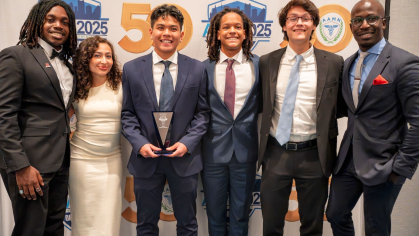Five Rutgers Professors Named Fellows of the American Association for the Advancement of Science
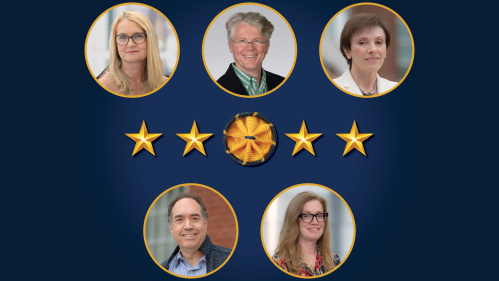
They are among 502 scientists, engineers and innovators recognized for their achievements
Rutgers faculty elected to the newest class of fellows of the American Association for the Advancement of Science (AAAS) have made a difference in the treatment of Parkinson’s disease, are advancing the understanding of how the brain processes rewards and motivates behavior and are tackling life-or-death questions regarding the success of cancer drugs.
Their work demonstrates the breadth of ongoing research at the university that is changing the world and making a difference in people’s lives. The five faculty members are working to address critical questions to improve public health, advancing our understanding of genetic-based disease and working on discoveries that could lead to new drugs to treat conditions like ischemic stroke, traumatic brain injury or spinal cord injury.
“The five newly inducted Rutgers fellows of the American Association for the Advancement of Science are at the leading edge of research in neuroscience and biological and medical sciences,” Rutgers President Jonathan Holloway said. “Each of them has been recognized by their peers for efforts to advance science and innovation for the benefit of all people, and their achievements illustrate the life-changing scholarship pursued by Rutgers’ exceptional faculty.”
Rutgers' AAAS fellows are among 502 scientists, engineers and innovators spanning 24 scientific disciplines ranging from research, teaching and technology to administration in academia, industry and government, to excellence in communicating and interpreting science to the public.
AAAS, the world's largest multidisciplinary scientific society and a leading publisher of cutting-edge research through its Science family of journals, announced the newest members of the class of fellows on April. 18. It is among the most distinctive honors within the scientific community.
Gary Aston-Jones
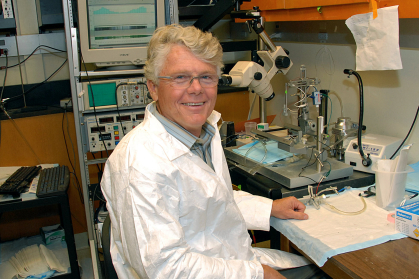
Murray and Charlotte Strongwater Endowed Chair in Neuroscience and Brain Health; Director, Rutgers Brain Health Institute
For innovation in the field of circuit and behavioral neuroscience, particularly using electrophysiology, neuroanatomy, and behavioral analyses to delineate brain mechanisms involved in human mental function and dysfunction
Gary Aston-Jones imagines a world where precision therapeutics are readily available for neuropsychiatric disorders and relief from extreme pain comes without fear of addiction.
For over four decades, the professor of psychiatry has been researching the mechanisms involved in cognitive function and dysfunction and advancing the understanding of how the brain processes rewards and motivates behavior – research that has implications for a wide variety of psychiatric disorders such as Alzheimer’s disease, autism, attention deficit disorder, addiction and depression.
As a graduate student, Aston-Jones made breakthrough discoveries in the locus coeruleus norepinephrine system. “This system, based in a small region in the brainstem, had long been known to be important in regulating sleep-wake cycles,” he said. “We discovered that it also facilitates attention, stress responses and adaptive behaviors in response to a changing environment. When it is not functioning properly, it contributes to all manner of neuropsychiatric disorders.”
Aston-Jones and his team also were the first to discover the role of the hypothalamic orexin brain system in reward and motivation. His research demonstrated how prolonged drug consumption causes drug-associated stimuli to activate orexin neurons and hijack the brain’s reward system, leading to compulsive drug-seeking behaviors. This work led him to target the orexin system for treatment of reward disorders including addiction. He secured a number of patents and is seeking pharmaceutical partners to move his research to therapeutic development. A recent pending patent concerns an approach to prevent development of an addiction phenotype while consuming prescription opioids to treat pain.
Aston-Jones added he is proud of the formation of the five centers of excellence and 35 faculty recruits at the Rutgers Brain Health Institute that he developed since his arrival at Rutgers in 2014.
“Our centers have done a remarkably good job of putting Rutgers neuroscience on the map. They are developing novel therapeutic approaches to treat addiction, autism, Alzheimer’s disease and a variety of other neuropsychiatric disorders,” he said. He also has been developing new centers in pain research and in auditory neuroscience research.
– Patti Zielinski
Maureen Barr
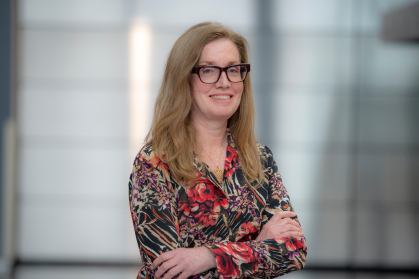
Distinguished Professor of Genetics, School of Arts and Sciences
For leadership in several aspects of ciliary signaling, including how cilia give off “messages” for cells that can be healthy or toxic and how cilia affected by genetic mutations can cause disease
Maureen Barr’s life changed as a Rutgers junior during a genetics class. Terry McGuire, her professor, projected an image on a screen of a pedigree analysis, a chart of a family tree marking members affected by a disease-conferring genetic trait.
“I said to myself, ‘I want to study this for the rest of my life,’” said Barr, now a Distinguished Professor of Genetics at Rutgers University-New Brunswick.
Since that day in a Rutgers classroom, Barr has emerged as a leader of her field.
Working with tiny worms the size of commas known as C. elegans, she has made several discoveries about cilia, fine, hairlike projections from cells, and their connection to genetic-based diseases.
In 1999 while working as a postdoctoral fellow at the California Institute of Technology, Barr and another Caltech scientist, Paul Sternberg, found that genes required for cilia function in worms have counterparts in humans that cause polycystic kidney disease. Until then, most human cilia were thought to serve little purpose. Cilia are now known – due to the work of Barr and others – as the antennas of the cell, conveying sensory information such as smell.
Barr dove into studies on how cilia form and showed that cilia affected by genetic mutations can cause multiple diseases called ciliopathies. Recently, Barr and members of her lab discovered that cilia release mysterious submicroscopic bubbles known as extracellular vesicles. The bubbles, they found, contain “messages” for cells that can be healthy or toxic.
Barr said she is most proud of the students she has mentored and her family. She and her husband Doug Tilton, whom she met when they competed as undergraduates on the Rutgers track team, have three sons. The eldest son is a Rutgers graduate and the younger two are Rutgers undergraduates.
“It’s been a beautiful journey,” she said.
– Kitta MacPherson
M. Maral Mouradian
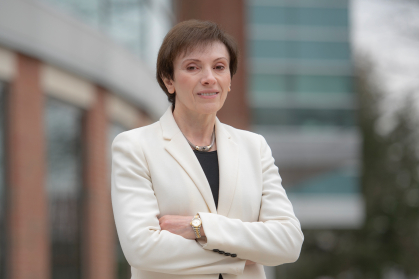
William Dow Lovett Endowed Chair for Parkinson’s Research and Distinguished Professor of Neurology, Robert Wood Johnson Medical School; Director, RWJMS Institute for Neurological Therapeutics; Vice Chancellor for Faculty Development, Rutgers Health
For advancements in the field of molecular and translational neuroscience, particularly for elucidating how age-related neurodegenerative diseases originate and develop and identifying novel therapeutic targets and agents
M. Maral Mouradian was always fascinated by the inner workings of the brain and later, as a young medical student, she became interested in pharmacology.
“I still remember the chapters in the classic pharmacology textbook by Goodman and Gilman in medical school,” she quipped, referring to the go-to resource in the field.
The combination of those interests led her to Parkinson’s disease for two reasons: It was the only neurodegenerative disorder for which there was an effective symptomatic treatment, but that treatment, L-dopa, had unacceptable complications. Mouradian thought she could make an impactful difference on the disease. She was right.
L-dopa is still the gold standard treatment of Parkinson’s to manage the tremors and slow movements. But Mouradian’s early work showed that the long-term use of this medication taken multiple times a day is not an optimal approach leading to changes in the brain that translate to an unstable benefit from the drug. Patients’ symptoms would return between doses, and more importantly, they would develop involuntary movements over time.
She discovered that if the patient took L-dopa continuously, instead of intermittently, it would normalize the way the brain responds to the drug and yield a smoother benefit throughout the day. Continuous delivery formulations of Parkinson drugs are now widely available to patients.
Parkinson’s is a neurodegenerative disease that affects as many as 1 million Americans and is characterized by tremors, slow movements, and a shuffling gait, according to the National Institute of Neurological Disorders and Stroke. There is no cure.
Mouradian has since focused her attention on finding treatments that change the course of the disease to slow down, stop the progression or even prevent the emergence of symptoms.
To that end, she has made a series of fundamental discoveries about the key pathogenic protein alpha-synuclein, which accumulates in abnormal forms in the brains of people with Parkinson’s disease. She has shown how this protein is cleared from cells, how its elevated levels are damaging to brain cells, and what factors lead to its assuming abnormal structures and causing disease. This multi-faceted body of work has identified several druggable targets, for which Mouradian has identified a series of compounds that she is currently testing. Her aim is to find a disease-modifying treatment.
Mouradian is also passionate about training the next generation of neuroscientists equipped to tackle currently incurable diseases. She directs the Training in Translating Neuroscience to Therapies program, funded by the National Institutes of Health, designed to give laboratory-based researchers, including graduate students, MD/PhD and postdoctoral fellows the knowledge and experience to take their discoveries at the bench to the clinic. It is one of only six such programs that NIH currently funds, she said.
“The fact that my early work actually resulted in improved therapies available on the market and people are benefiting from them is very rewarding,” she said.
– Roya Rafei
Christopher Rongo
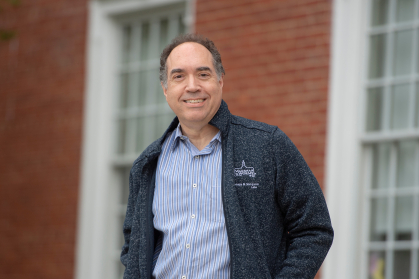
Professor of Genetics, School of Arts and Sciences and Waksman Institute of Microbiology
For innovation in the field of synaptic cell biology, particularly how cellular reaction to oxygen deprivation plays a critical role in understanding many diseases, including stroke
Christopher Rongo is the kind of researcher who tends to pivot after a set of discoveries.
“There are some scientists who like to study the same thing their entire career and there are others who drift. I’m in the drift category,” Rongo said. “I started out my career asking very simple questions about how the nervous system gets wired up and the answers I got led me to the field of hypoxia or low-oxygen stress.”
Rongo uses the genetic makeup of roundworms, called C. elegans, to study the human nervous system. Roundworms are tiny creatures – about 1 millimeter long, the size of a sharp pencil’s tip – with a primitive nervous system, 302 neurons compared to billions in the human brain. But they have transparent bodies, allowing scientists to actually see how the worm’s nervous system works and repairs itself. Rongo specifically looked at how neurons and other cells in the roundworm respond to and survive a decrease in oxygen levels.
Oxygen deprivation, scientifically called hypoxia, and how cells react to this loss, plays a critical role in understanding many conditions and diseases in humans. Heart attacks or strokes are examples of hypoxia: the blockage of blood vessels leads to oxygen deprivation in the heart or brain. But oxygen deprivation also plays a part in understanding other conditions. Cancer cells, for example, survive by taking over the body’s system for surviving hypoxia. Medication that blocks cancer cells from hijacking this system could help patients manage their conditions.
“I wanted to understand why our neurons don’t do so well under hypoxia and these other organisms, including the worm, do,” Rongo said.
Hypoxia research in these roundworms has already helped to find treatments for other ailments like chronic kidney disease, allowing patients to manage their condition, Rongo said.
In the long run, he hopes his research will lead pharmaceutical companies to develop drugs to treat conditions like ischemic stroke, traumatic brain injury or spinal cord injury.
Rongo is pivoting again. He is also working with a biotech company to find ways to heal chronic wounds, particularly in patients with diabetes.
“I’m learning a whole new research field and engaging with clinicians, which keeps me from getting bored,” he said. “I’m excited about the possibility of my work actually helping people who are suffering.”
– Roya Rafei
Kathleen Scotto
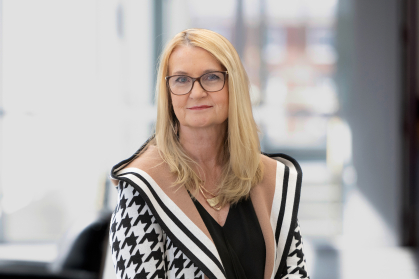
Professor of Pharmacology, Robert Wood Johnson Medical School; Vice Dean, School of Graduate Studies; Vice Chancellor for Research and Research Training, Rutgers Health
Distinguished contributions to understanding the mechanisms underlying tumor response to therapeutic and environmental stress, leadership in biomedical research, and commitment to research training
Why do cancer treatments succeed in some patients but fail in seemingly identical ones? Why do effective treatments often stop working? Kathleen Scotto has spent a career seeking answers to those life-or-death questions.
“Cancer cells vary so much that no one thing will kill them all,” Scotto said. “Some people are more likely to get certain cancers because of their DNA. Cancer also mutates so quickly inside individuals that individual tumors soon have different cancer cells that respond to different therapies.
“I've spent most of my career looking at the underlying molecular mechanisms, with the idea that understanding why certain tumor cells survive drugs that kill most tumor cells will show us other ways to treat.”
Scotto was the first to clone a gene that makes a protein called P-glycoprotein, which prevents drugs from entering cells. She then discovered how the gene worked and how it could be activated in patients undergoing chemotherapy.
Scotto has also contributed directly to the approval of at least one drug, the chemotherapy medication trabectedin, which sells under the brand name Yondelis.
“A Spanish company wanted to develop drugs from organisms it hauled out of the sea,” Scotto said. “It would send out boats with nets and examine anything they dragged in for unknown marine proteins. After finding something with apparent anti-cancer activity, they asked our lab to analyze its mechanism of action, and that work supported approval for the drug, which is now owned by Johnson & Johnson.”
As a senior administrator, Scotto now spends much of her time recruiting other researchers and supporting their efforts.
She retains her passion for research, though, and thinks her most recent work ranks among her best. Her lab has discovered that another of the proteins that determines what can pass through a cell membrane is also involved in a vital process called autophagy, in which the body replaces defective cell parts and recycles their components.
“I have long studied drug transporters, structures that sit on the outside membrane of a cell and either allow drugs to get into the cell or block their entry,” Scotto said. “But it turns out that they do more than that in cancer, actually allowing cancer cells to survive in stressful environments. That publication should appear this month.”
– Andrew Smith


